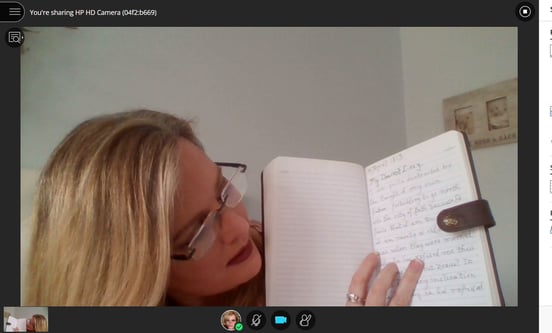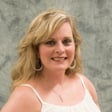Is high school different in a cyber school? Find out what it's like to teach at a cyber charter high school, featuring English teacher Ms. Slater!
High school: a time full of excitement for selecting a prom dress, guessing who will be on the royal court at homecoming, and even late-night prepping for SAT exams.
Before we know it, students have to learn how to negotiate peer relationships in person and on social media. Meanwhile, something that once was just an interest is becoming a potential career choice. For some students, in addition to all of these major life changes, there’s also a need to find a high school that better fits their needs. While some choose to stay in their local school, others take the leap into cyber charter learning and the flexibility it offers.
Today, I’m going to give you a behind-the-scenes look at life as a high school teacher — and what I appreciate most about my students and my work!
 A unit project example
A unit project example
Getting Started
It’s important to note that the desire for a full high school experience does not change when a student decides to attend a cyber charter school. What does change is the way in which that goal is achieved.
One of the biggest hurdles to learning online at the high school level is how older learners are engaged in the classroom. Most, if not all students today, have experience with learning through virtual settings. For some, that experience was not positive. For others, they found a great deal of benefit to learning outside of the traditional classroom. The differences between these two experiences is due largely to how engaged they were with their teachers and with their peers.
I taught in a brick-and-mortar setting for nearly 10 years, and have taught in cyber charter school for more than 16 years. One question that I am asked frequently is whether or not I miss being in front of a classroom. Here’s the thing: I AM in front of a classroom! Like other teachers, my objective is to make sure my students connect with the course content in meaningful ways — and I gladly do that in a physical classroom, or virtually. The satisfaction I derive from teaching all these years has not been determined by whether I am in a school building or on a camera.
Walk with me as I share my experience as a teacher for grades nine through 12 at a cyber charter school, and discuss some of the benefits and challenges of teaching virtually.
Engaging with High Schoolers
Engaging students in any setting is a challenge, and while being at home can have its distractions for some students, I can honestly say that the trials that they face in the traditional classroom are far more distracting! Battling the bullying and hourly hallway interactions with students in a brick-and-mortar school is far more than many young people can take. For those students who face constant hostility, cyber education is a safe haven where they can focus solely on their education. Once they can focus, then engagement is much more successful.
As a cyber teacher, I always start my classes at the beginning of the school year by getting on the webcam to introduce myself, giving students a chance to see that there is a person behind the voice that they will hear each day. After my beginning of the year introduction, I use the webcam more as a tool to demonstrate a concept, draw attention to an idea, or simply to do something funny to hold their attention.
Since there can be limits to how webcams are used, I have found many other ways to keep students involved in their learning. I also require my students to use their microphones as part of their experience. While one person is using the microphone, several students can use the chat feature, emoticons, and more to share their support and ideas in real time, rather than waiting with a hand waving in the air in the hopes of being recognized.
And let me tell you, students want to have those ideas acknowledged! For that reason, my classroom sees a constant exchange of ideas, as students share their thoughts and get real-time support and feedback from their peers.
In addition to using the microphone and other features, I begin my classes using a PowerPoint slide that has some type of seasonal background to keep students interested. That slide features the class agenda, any necessary links, homework, and class objectives for that day.
After reviewing the agenda, we’re off on a learning adventure! I tend to do a variety of activities throughout the week, so that the class does not feel stale. I draw heavily on small group work, which teaches students to become independent learners. Groups work on close reading activities, prepare in-class presentations, provide peer feedback on essays and projects, complete study guides, and more. I check in with each group to guide them through the topic, before everyone reconvenes as a class.

Showing a "Pride and Prejudice" class project
It isn’t all just lecture and small group work, though, and I use videos, audio recordings, and web tours to support my teaching. Since I teach British literature, I also, by extension, teach a great deal of history. It is nearly impossible to teach Chaucer without instructing the students as to the significant historical events occurring during the Middle Ages in England.
Rather than have students always follow a PowerPoint or read an article, however, I’ve found a more effective solution: movie day! Just like in a brick-and-mortar classroom, movie day is a change of pace that keeps students engaged — and allows me to draw on more visual resources.
It’s one thing to read about the homes and places where authors wrote their masterpieces and lived, but it’s entirely different to watch a video series on the topic. Similarly, taking a virtual tour of, say, Jane Austen’s home — the one in which she wrote Pride and Prejudice or Sense and Sensibility — reinforces that these authors were real people living in time periods quite different from our own. While watching the tour or video, students work on a study guide or even collaborate on a scavenger hunt! Making sure that students have a great deal of contact with others in the class is vital to ensuring that they do not feel like they are learning in a vacuum.
Benefits and Challenges of Teaching Online
One of the greatest benefits of teaching in an online classroom is the ability to teach from home. I was quite reluctant to make such a change from in-person to online, and while there was definitely a learning curve, there were some unexpected surprises.
Many people now understand the benefits of working from home, such as relaxing in your own home, wearing more comfortable clothes, and being home when the kids get off of the bus. For me, one of the greatest advantages is the satisfaction of still truly educating young people. I thought that might be a sacrifice that I would be making early in my online career; however, it could not be further from the truth.
Three years ago you would be hard pressed to find a teacher that had much, if any, online teaching experience. But, due to the COVID-19 pandemic and an emphasis on online teaching, there are plenty of articles, conversations, interviews, stories, and more about how many teachers struggled to adapt in 2020 and 2021. They had to figure out how to instantly change their teaching methods from in-person learning to online platforms. Much of the difficulty that they experienced was due to having to establish a classroom with very little guidance — and all of this led to a great deal of misconceptions about cyber education.
 |
| A "Wuthering Heights" inspired newspaper project |
I have found that one challenge that all educators face is students taking responsibility for their own learning. This is even more crucial in a cyber learning environment. Without a teacher or other adult present to keep an adolescent on task, a less responsible student can find themselves in danger of failing classes very quickly. At PA Virtual, there must be an adult at home (considered the Learning Coach), present and ready to help students with concerns, while ensuring students attend classes and complete assignments.
New students must successfully complete a two-week orientation before beginning their classes, which gives them a glimpse into what the school day looks like and prepares them for the responsibilities that come with attending cyber school. These educators raised questions of how to hold students accountable, how to keep them engaged, how to get them to complete their work, and more. These are all very real questions and concerns, but many of these educators merely needed guidance from someone with years of tackling these barriers!
I entered online teaching with a group of pioneer educators (and with what today are very antiquated platforms). We set out to figure ways in which we could effectively provide the same quality of education as we had previously provided in traditional classrooms. We worked tirelessly for nearly 20 years, and through many successes and failures we found what we needed to do not only to succeed as educators, but most of all for our students to succeed as well.
Altering perceptions of how to evaluate students is another hurdle. Personally, I use multimedia, multifaceted, unit projects in place of tests. Giving traditional assessments can allow for students to search for answers online, thus negating the data needed to determine whether students have retained the information taught. Using individual projects and group projects created in class and in collaboration with other students allows me to not only assess knowledge, but also to give students opportunities to explore new platforms that they may not have otherwise used. I still use in-class quizzes and quiz game applications, as well as more traditional assignments of vocabulary, study questions, essays, discussion boards, and blogs and more. Every school year there are more unique opportunities, unique platforms, and unique ways to educate students online.
Some Final Reflections
My life as an online high school teacher has not altered who I am as an educator. I am still true to the teacher I was years ago in a brick-and-mortar classroom. Just like anything we face in life there are advantages and disadvantages to cyber school. Finding the right fit in any situation is always critically important. However, teaching online has allowed me the opportunity to continue to teach young people a subject that I love, and continue to push the frontiers of education in new and exciting ways.
Ready to learn more?
Note: This blog post was originally published in March 2022, and has been updated for accuracy of content.
 About the Author: Pam Slater is an English teacher in the high school at PA Virtual.
About the Author: Pam Slater is an English teacher in the high school at PA Virtual.
Photo credits to LinkedIn Sales Solution on Unsplash; others from Pamela Slater.






Comments